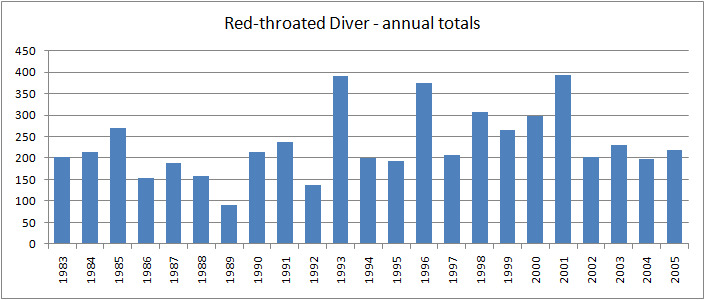Gavia stellata
Winter visitor and passage migrant.
The Red–throated Diver has a circumpolar Arctic breeding distribution, the nearest nesting to Pembrokeshire being in Scotland. Those on the eastern side of the Atlantic winter southwards to the Bay of Biscay, sometimes entering the Mediterranean.
Mathew (1894) and Lockley et al (1949) considered the Red-throated Diver to be a common winter visitor. The former gave no actual counts and the latter noted only a group of 20 off the west coast and 15 off Giltar Point.
Bertram Lloyd (1939) recorded all the Red–throated Divers seen during his intermittent visits to the county during the period 1929 – 37. The places he saw them coincided with localities where they were noted in the 1980’s and 1990’s, as did the numbers involved. This led Donovan and Rees (1994) to think that perhaps this diver’s status had not changed in the previous 60 years or so.
Dickenson and Howells (1962) commented that almost every winter small numbers of Red–throated Divers had been seen off both the west and south coasts of Pembrokeshire, from mid October to the end of April. That they had been recorded within Milford Haven and Fishguard Harbour and that R. M. Lockley had told them that he recorded them frequently on his winter journeys from Skokholm to the mainland between 1927 and 1940. They went on to note that from the numbers recorded in the last decade it is possible that a decrease had taken place since the 1930’s.
The average number recorded in the 1930’s was 10 per annum which included 43 noted in 1930. The average recorded from 1952 to 1961, the period covered by the Dickenson and Howells review, was only 5 per annum, the most in any year being 10 in 1961.
The average on record for the years 1963 to 1982 was 6 per annum, the maximum in any year being 23 in 1973. How much credence can be put into these statistics being representative of the true picture is brought into question, when considering that in the period 1983 to 2002 an average of 225 per annum were put on record, the largest total in a year being 394 in 2001.
There was a marked increase in the number of active observers during the 1980’s and 1990’s, they possessed ever improving optical aids and most had the discipline to contribute their observations to the communal record. These are likely to be the factors that explain the upsurge in records, rather than there being an increase in the number of Red–throated Divers visiting Pembrokeshire.
TOTALS RECORDED 1983 – 2005
 These totals have been calculated by summing the maximum for each locality in each season and the number seen visibly migrating. They do not attempt to assess any possible turnover in numbers at specific sites and the migrant totals would have been influenced by the amount of time spent watching from headlands and islands. It is likely therefore that the totals represent the minimum presence in local waters.
These totals have been calculated by summing the maximum for each locality in each season and the number seen visibly migrating. They do not attempt to assess any possible turnover in numbers at specific sites and the migrant totals would have been influenced by the amount of time spent watching from headlands and islands. It is likely therefore that the totals represent the minimum presence in local waters.
References
DICKENSON. H and HOWELLS. R. J. 1962. Divers in Wales, Nature in Wales 8.
DONOVAN. J and REES. G. 1994. Birds of Pembrokeshire, Dyfed Wildlife Trust.
LLOYD. B. 1929-1939 Diaries, National Museum of Wales.
LOCKLEY. R. M, INGRAM. C. S. and SALMON. H. M.1949. The birds of Pembrokeshire, West Wales Field Society.
MATHEW. M. 1894. The birds of Pembrokeshire and its islands, R. H. Porter
 Wednesday, September 18, 2013 at 8:21AM
Wednesday, September 18, 2013 at 8:21AM 




